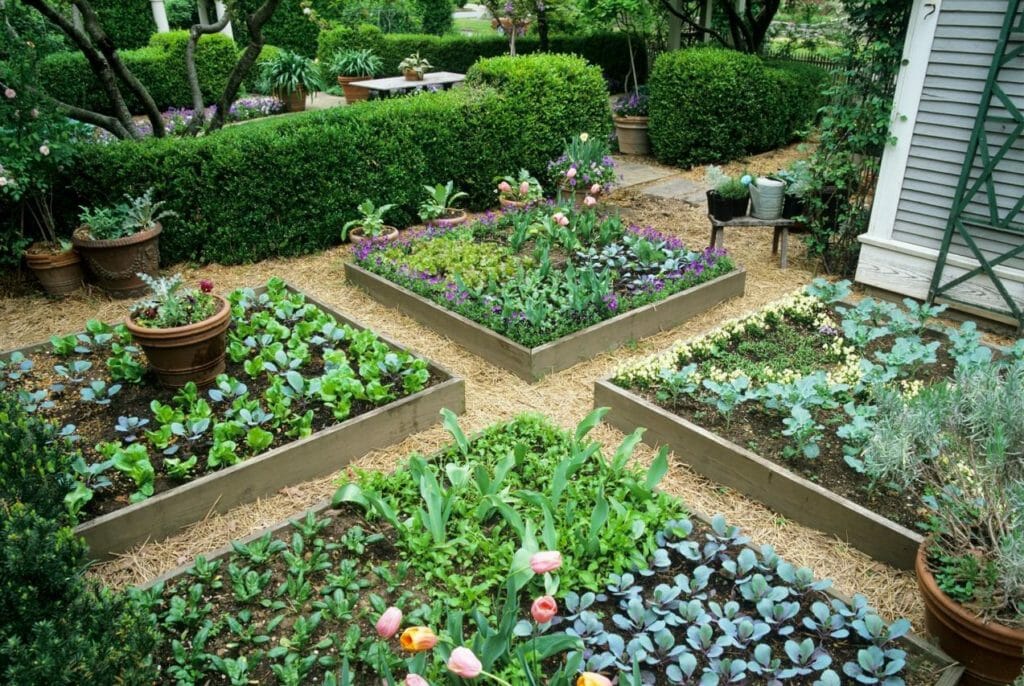With spring finally here, you may be considering putting in a raised bed garden. But if you’ve headed to your local garden supply center, you (and your budget) may have recoiled in shock.
Instead of crossing “raised beds” off your to-do list, consider some of these budget friendly ideas that can get your garden up and growing quickly.
Making the Bed
Often, the biggest expense for raised beds is the actual bed itself. Find ways to reduce the cost of your raised bed by thinking outside the box.
1. Lose the bed. Want to really cut costs? Don’t use a box at all. Build your raised bed by creating mounds wherever you want your bed to be located. Simply put down a layer of newsprint, followed by a two-inch layer of grass clippings or shredded leaves. Include a layer of manure, followed by a layer of top soil. The rounded edges help rain to run off, and the elevated bed helps prevent it from being trampled by mowers or walkers.
2. Use recycled materials. If your garden also doubles as a yard for small children or animals, you may need a raised bed with walls. Look for pieces that can be repurposed: old cribs, galvanized tubs, old fence rails or scrap lumber. A quick-and-easy bed can be made out of concrete blocks. For a natural look, use tree stumps, rocks or reclaimed concrete. Scour your local classifieds or Craigslist ads for free items that you could use to build a garden bed.
Need Non-GMO Heirloom Seeds? Get Them From A Company You Can Trust!
3. Build on the cheap. Really like the look of a wood bed, but don’t want the expense? Visit the fencing section of your local lumberyard. Purchase individual fence slats to build the walls of your bed. Cedar is weather-proof and makes a great raised bed. Look for untreated lumber if you’re planning on growing food. Pallets can be found easily and can be used to build your bed.
Filling the Space
4. Make your own soil. Bags of growing medium can add cost to the project quickly. For best results, and for maximum growth potential, create layers in the growing box. Not only will it cut down on the cost of soil, but it will give your garden the nutrients it needs to produce a bountiful harvest. Every gardener has their own “special sauce” of growing soil — a mixture of dirt, fertilizer and other additives that they’ve had success with. The basic formula I use, however, looks like this:
Start with a layer of weed block. (I prefer three layers of newspaper; it’s effective at stopping weeds and grasses from getting through and will break down over time.)
Add two inches of “green material.” Leaf clippings, grass cuttings and other yard waste is perfect here. A neighbor of mine swears by the fact that he adds a bag of Old Roy dog food to the raised beds. While I’m not sure what the dog food does, you can’t argue with his results! His garden overflows with food year-round! (Don’t have a lot of leaves to use? Ask your neighbors to save their grass cuttings; most people will be happy to have someone else dispose of their yard waste!)
Add a layer of mulch. This helps to hold moisture in the garden bed, and provides additional nutrients as the mulch breaks down. (Be sure to get “natural” mulch. Check with your local extension office for free mulch that may be available.)
Add a layer of dirt. I prefer to mix my soil with worm compost before adding it to my raised bed, to ensure even coverage. Add a few inches of soil to the top of your garden.
Seamazing: The Low-Cost Way To Re-mineralize Your Soil
For extra help with water retention, I like to cover my raised bed with hay or mulch after putting in my plants. It helps to prevent weeds from taking root, and holds in moisture, essential in the hot climate where I live.
Adding Your Plants
5. Don’t pay for high-priced seedlings. Start your own seedlings, using last year’s seeds or seeds you purchase.
Or visit local garden shows, small nurseries or other garden centers for inexpensive seedlings. Check with your extension office for “plant swaps” and other plant-sharing events that will allow you to share (and receive) plants from other gardeners. Make friends with people who garden – most gardeners love to share their plants and will offer cuttings or seedlings to get your garden started.
A raised bed doesn’t have to break the bank. You can find ways to garden “on the cheap,” giving you and your family access to delicious fruits and vegetables right outside your door.
Be creative – your garden can be as unique and individual as you!
What advice would you add on building an inexpensive raised bed? Share your tips in the section below:
 Off The Grid News Better Ideas For Off The Grid Living
Off The Grid News Better Ideas For Off The Grid Living




